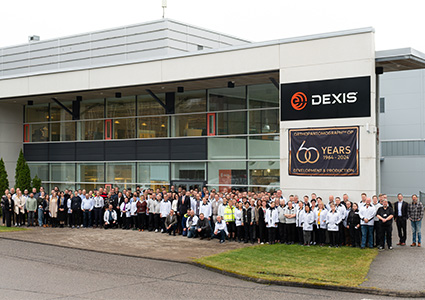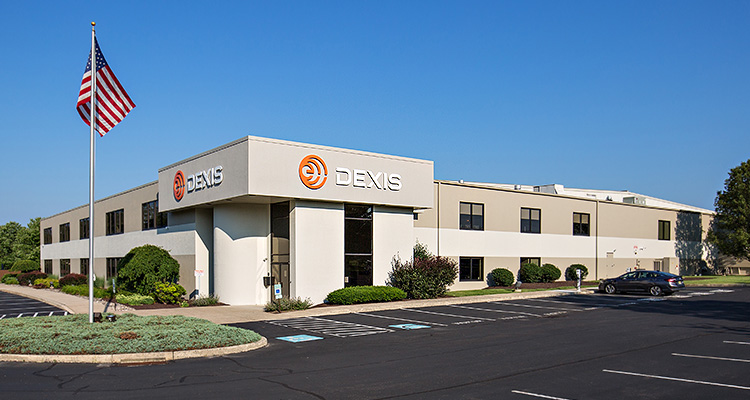In its pursuit of excellence, Envista – DEXIS redefines the standard of care for professionals and patients alike
Composed of over 30 trusted dental brands, Envista prides itself on partnering with professionals to deliver the best possible patient care through industry-leading products, solutions, and technology. The group’s comprehensive portfolio includes dental implants and treatment options, orthodontics, and digital imaging technologies that are critical for diagnosing, treating, and preventing dental conditions.
As part of Envista, DEXIS manufactures dental imaging devices with a strong emphasis on innovation, with a range of trusted products developed through over 70 years of expertise. Today, over 150,000 DEXIS imaging devices are being utilized in dental practices around the world, such as its groundbreaking i-CAT™ and ORTHOPANTOMOGRAPH™ OP 3D™. As Global Vice President of Operations & Customer Experience, Ferdinand Schoeferle is well-placed to discuss DEXIS’ R&D facilities and the role they play in the company’s operations. 
“We have six R&D sites around the world, including ones in Finland and the US. Over the last 60 years, our Finnish team has mainly focused on manufacturing 3D cone-beam computed tomography (CBCT) technology. Meanwhile, our US facility in Quakertown, Pennsylvania, acts as our 2D Center of Excellence. However, it also houses a 3D imaging device and our factory in Tuusula, Finland possesses a 2D imaging device. Our R&D efforts are concentrated on large imaging equipment in Tuusula and on 2D intraoral sensors and software in Quakertown. As our manufacturing and distribution hub for the US, the Quakertown plant functions with a hands-on approach to assembly, picking, packing, and shipping processes. In contrast, our facility in Finland is more dedicated to the actual manufacturing of our devices starting from raw components, though it still relies on human assembly,” he begins.
Mr. Schoeferle now gives the spotlight to his colleague in Tuusula, Leena Mäkisalo, who serves as Director of Operations in Finland. Ms. Mäkisalo introduces us to the facility that enable DEXIS’ operations in the country. “At our manufacturing site, we employ approximately 140 skilled people, with an additional 80-to-90 individuals working in R&D, human resources, quality assurance, support functions, and more. Our operations in this facility cover the entire manufacturing process for our dental imaging devices. This includes a machine shop where we fabricate the aluminum parts, as well as an assembly area for manufacturing the X-ray components, such as tube heads and collimators. Subsequently, we assemble the products on our assembly line before testing, packing, and shipping them to our customers. In addition, our repair team in Tuusula is focused on large units, enabling them to perform on-site repairs for clients. For smaller items requiring repair, we fix them in our repair units before returning them to customers. We also keep an inventory of spare parts, allowing customers to request any part they need, and then we ship the parts quickly from Tuusula or Quakertown,” she enlightens.
Dana Moore, Director of Operations for the US, discusses DEXIS’ relentless pursuit of optimization and efficiency, not only in terms of products, but also processes. “Alongside launching many new products, we are committed to continuously improving our manufacturing efficiency and quality by using lean tools. If we were to make a component with high failure rates, we would seek an alternative component that enhances the overall quality of the product. While we emphasize embedding quality in our processes, there is still some occasional rework that may be necessary if we come across an issue. Thus, we are constantly looking for ways to increase the overall quality of our products and components, ensuring they make their way through the production line without any problems. On the operational front, we maintain the same dedication to continuous improvement around components, processes, and ultimately productivity, with a focus on facilitating operators’ tasks. In fact, we refrain from setting up production lines in a way that is inefficient or frustrating for operators. Instead, we undertake a variety of initiatives, like Kaizen events where we involve operators to understand their perspective and points of frustration. As a result, we can learn and act on those areas.”
 Following on from that, Ms. Mäkisalo provides an example of how DEXIS has changed one of its processes to make the manufacturing of a specific product more efficient. “Five years ago, one of our legacy product lines, a CBCT scanner, was made up of approximately 3500 different components. Our R&D team has since designed a new version with similar uses that is a step up from the previous iteration of the product, consisting of only 800 parts. During the R&D phase, we were particularly fixated on ensuring the manufacturability of the unit, aiming to manufacture it faster and with a reduced likelihood of errors throughout the process. This focus on manufacturability remains crucial to us throughout the entire product life cycle, starting from the R&D phase and extending to the design process. We also carefully consider factors like the variety of screws used or whether to employ a single or several different standards across multiple components. For instance, instead of stocking four different types of screws for four models, we can standardize on a single screw type across all models, thus optimizing our supply chain,” she says.
Following on from that, Ms. Mäkisalo provides an example of how DEXIS has changed one of its processes to make the manufacturing of a specific product more efficient. “Five years ago, one of our legacy product lines, a CBCT scanner, was made up of approximately 3500 different components. Our R&D team has since designed a new version with similar uses that is a step up from the previous iteration of the product, consisting of only 800 parts. During the R&D phase, we were particularly fixated on ensuring the manufacturability of the unit, aiming to manufacture it faster and with a reduced likelihood of errors throughout the process. This focus on manufacturability remains crucial to us throughout the entire product life cycle, starting from the R&D phase and extending to the design process. We also carefully consider factors like the variety of screws used or whether to employ a single or several different standards across multiple components. For instance, instead of stocking four different types of screws for four models, we can standardize on a single screw type across all models, thus optimizing our supply chain,” she says.
By constantly refining its processes, DEXIS fulfils its commitment to minimizing its environmental impact. “In Finland, we organized a Kaizen event around waste flows in and out from our factory. One aspect involved the delivery of our sensors in large foam packages to prevent breaking as they are highly sensitive. During that event, we transitioned to using recycled cardboard packaging, which is not only more cost-effective but also environmentally friendly. We seized this opportunity to calculate our energy usage, wastewater production, and other waste components to identify areas for improvement and strengthen our waste management practices. Additionally, at our machine shop in Tuusula, we grind and cut our own aluminum parts. This process generates aluminum byproducts, which are fully recycled and compacted into solid aluminum before being sold back to our aluminum supplier,” Ms. Mäkisalo ends.
Through its relentless drive for innovation and excellence, DEXIS stands as a leading technology manufacturer in the dental industry.
